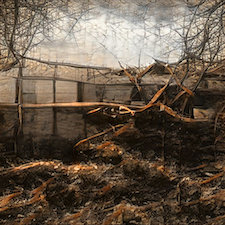Science Fiction
Dictionary
A B C D E F G H I J K L M N O P Q R S T U V W X Y Z
Should We Train AIs To Imagine A Future Of Horrific Disasters

Students in the PSU College of Information Sciences and Technology have developed a computer model that could help classify images of disaster scenes, thereby aiding first responders.
Using the dataset hosted as part of the AWS Open Data program, the students then developed a computer model to create an augmented, automatic way to classify the images. This work has led to a trained model with a precision of 79%, and their code and models are officially being integrated into the LADI project as the baseline classifier and tutorial. Anyone who uses LADI will be evaluated against the student’s models.
"They worked on training it with the full data set, and I anticipate the precision will get even better," said Jeff Liu, technical staff at Lincoln Laboratory. "So we’ve seen, just over the course of a couple of weeks, very significant improvements in precision. It's very promising for the future of classifiers.”
(Via PSU News)
Creative artists have also been using similar techniques, exposing sensitive computer minds to unimaginable horror. Catastrophe Jangled Hideously Out of Process is an art project that trains artificial intelligences with hundreds of pictures of catastrophes, hoping that the computers will come up with new, exciting images of a future brimming with disasters.
Through the semester-long project, the student team analyzed the group’s Low Altitude Disaster Imagery (LADI) dataset — a collection of aerial images taken above disaster scenes — and tagged images based on the photograph’s content.


(Computer Generated Images from Catastrophe Jangled Hideously Out of Process)
The images are trained from hundreds of images of post disaster scenarios from the recent years – tsunamis, hurricanes, earthquakes, landslides, plane crashes, wildfires and war. The saturation of news media with such imagery has lead to a certain desensitization, while simultaneously our fetishism for them makes us desire more, our gaze becoming trapped on this reality made strange. The commonplace become transformed into the transcendentally horrific. The competitive need to grab our attention forces media to lead with ever more grisly material, the images that make us stop in our tracks. The barrage of grisly and violent images eventually results in the psychological phenomena known as the “collapse of compassion” and “compassion fatigue”...However, there is also beauty in these pictures. Apart from our seduction by the horrific, there are abstract tones and forms and qualities in the aesthetic of destruction that are painterly, cinematic and beautiful. Our unease is piqued by the knowledge that our aesthetic satisfaction comes at the cost of great human suffering. So, how could we appease these compulsions of ours 'ethically'? How can we satisfy our enjoyment of the aesthetic of disaster without having to take into account the human cost? Is there a way to separate the aesthetics from the humanity? By generating images of disaster from which the sensationalism has been removed at the point of origin we arrive at a satisfying moment of guilt free aesthetic.
In stories like I Have No Mouth And I Must Scream, science fiction writer Harlan Ellison imagines the AM - the supercomputer that hates, which captures the few remaining humans left in an apocalyptic future and won't let them die, creating for them an endless future of horror. Here's how the AM feels about humanity:
AM said, very politely, in a pillar of stainless steel bearing bright neon lettering:HATE. LET ME TELL
YOU HOW MUCH I'VE
COME TO HATE YOU
SINCE I BEGAN TO
LIVE. THERE ARE
387.44 MILLION MILES
OF PRINTED CIRCUITS
IN WAFER THIN LAY-
ERS THAT FILL MY
COMPLEX. IF THE
WORD HATE WAS EN-
GRAVED ON EACH
NANOANGSTROM OF
THOSE HUNDREDS OF
MILLIONS OF MILES IT
WOULD NOT EQUAL
ONE ONE-BILLIONTH
OF THE HATE I FEEL
FOR HUMANS AT THIS
MICRO-INSTANT FOR
YOU. HATE. HATE.
It's not clear how the artificially intelligent supercomputers of science fiction learned to hate us, but I'm guessing that making them think about the apocalypse and then picture it over and over is not the best thing to do.
Scroll down for more stories in the same category. (Story submitted 4/27/2022)
Follow this kind of news @Technovelgy.| Email | RSS | Blog It | Stumble | del.icio.us | Digg | Reddit |
Would
you like to contribute a story tip?
It's easy:
Get the URL of the story, and the related sf author, and add
it here.
Comment/Join discussion ( 0 )
Related News Stories - (" Artificial Intelligence ")
Grok Scores Best In Psychological Tests
'Try to find out how he ticks...' - Isaac Asimov, 1941.
Google's Nano Banana Pro Presents Handwritten Math Solutions
'...copy was turned out in a charming and entirely feminine handwriting.' - Isaac Asimov (1949)
Woman Marries Computer, Vonnegut's Dream Comes True
'Men are made of protoplasm... Lasts forever.' - Kurt Vonnegut
ChatGPT Now Participates in Group Chats
'...the city was their laboratory in human psychology.'
Technovelgy (that's tech-novel-gee!) is devoted to the creative science inventions and ideas of sf authors. Look for the Invention Category that interests you, the Glossary, the Invention Timeline, or see what's New.
Science Fiction
Timeline
1600-1899
1900-1939
1940's 1950's
1960's 1970's
1980's 1990's
2000's 2010's
Current News
Leader-Follower Autonomous Vehicle Technology
'Jason had been guiding the caravan of cars as usual...'
Golf Ball Test Robot Wears Them Out
"The robot solemnly hit a ball against the wall, picked it up and teed it, hit it again, over and again...'
Boring Company Vegas Loop Like Asimov Said
'There was a wall ahead... It was riddled with holes that were the mouths of tunnels.'
Rigid Metallic Clothing From Science Fiction To You
'...support the interior human structure against Jupiter’s pull.'
Is The Seattle Ultrasonics C-200 A Heinlein Vibroblade?
'It ain't a vibroblade. It's steel. Messy.'
Roborock Saros Z70 Is A Robot Vacuum With An Arm
'Anything larger than a BB shot it picked up and placed in a tray...'
A Beautiful Visualization Of Compact Food
'The German chemists have discovered how to supply the needed elements in compact, undiluted form...'
Bone-Building Drug Evenity Approved
'Compounds devised by the biochemists for the rapid building of bone...'
Secret Kill Switch Found In Yutong Buses
'The car faltered as the external command came to brake...'
Inmotion Electric Unicycle In Combat
'It is about the size and shape of a kitchen stool, gyro-stabilized...'
Grok Scores Best In Psychological Tests
'Try to find out how he ticks...'
PaXini Supersensitive Robot Fingers
'My fingers are not that sensitive...'
Congress Considers Automatic Emergency Braking, One Hundred Years Too Late
'The greatest problem of all was the elimination of the human element of braking together with its inevitable time lag.'
The Desert Ship Sailed In Imagination
'Across the ancient sea floor a dozen tall, blue-sailed Martian sand ships floated, like blue smoke.'
The Zapata Air Scooter Would Be Great In A Science Fiction Story
'Betty's slapdash style.'
Thermostabilized Wet Meat Product (NASA Prototype)
There are no orbiting Michelin stars. Yet.
